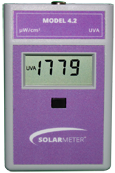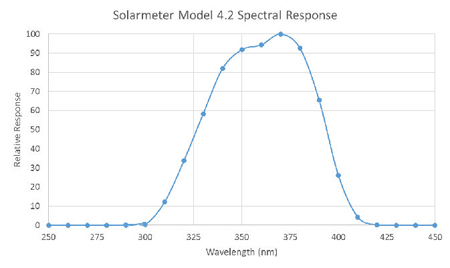
SOLARMETER ® 4.2 UVA
The Model 4.2 features an Integral Sensor and applications include window tint tests, fabric & clothing protection, household lamps, stadium lighting, outdoor shaded area's and other low level UV sources.
| Specifications | Radiometer |
| Model | 4.2 |
| Irradiance Range | 0-1999 µW/cm² UVA |
| Response | 320-400 nm (UVA) |
| Resolution | 1 µW/cm² |
| Conversion Rate | 3.0 Readings/Sec |
| Display | 3.5 Digit LCD |
| Operating Temps | 0° C to 40° C |
| Operating Humidity | 5% to 80% RH |
| Accuracy | ±10% REF.NIST |
| Dimensions (LxWxD) | 10.5 x 6 x 2.2 cm |
| Weight | 110 Grams |
| Power Source | 9-Volt DC Battery |
| Lens | UV Glass |
| Diffuser | Teflon |

To enquire on the the Model 4.2 please click on the link below or use the contact page.
When requesting a quote please provide quantity and suburb/state for postage/delivery details.
Sensor
The sensor consists of a GaAsP photodiode and a UV filter. It is completely insensitive to visible light longer than 400nm and infrared radiation because its spectral response only covers the UVA region from 320-400nm. Applications include solar UV detection as a spectral response is well matched to the solar UV spectrum.
Operation
Press and hold push-button switch on face of unit. Aim sensor window in top panel of meter directly at UV source. Note reading on LCD and record if desired.
Battery operation voltage is 9V down to 6.5V. Below 6.5V the LCD numbers will begin to dim, indicating the need for battery replacement. Under "typical" service load, the battery should last about 2 years.
The sensor consists of a GaAsP photodiode and a UV filter. It is completely insensitive to visible light longer than 400nm and infrared radiation because its spectral response only covers the UVA region from 320-400nm. Applications include solar UV detection as a spectral response is well matched to the solar UV spectrum.
Operation
Press and hold push-button switch on face of unit. Aim sensor window in top panel of meter directly at UV source. Note reading on LCD and record if desired.
Battery operation voltage is 9V down to 6.5V. Below 6.5V the LCD numbers will begin to dim, indicating the need for battery replacement. Under "typical" service load, the battery should last about 2 years.
Proper Usage of Solarmeter ® Ultraviolet Radiometer for low level UV measurements.
- When checking home, business, school, or car window UV transmission, take reading through window or film and compare to outdoor reading.
- For household lighting including compact fluorescents, take reading near lamps and again at several inches or feet distance, to see how far away the UV falls below 1 uW/cm².
- For gym or stadium lighting take readings at floor level. If concerned about amount of UV, ask the owners to have UV-block shields installed under the lamps.
- Do not subject the meter to extremes in temperature, humidity, shock or dust. Store meter away from humidity when not in use.
- Use a dry, soft cloth to clean the intrument. Keep sensor free of oil, dirt, etc.





















